人教版九年级英语Unit 13 We’re trying to save the earth!全单元学案
- 格式:doc
- 大小:99.00 KB
- 文档页数:11

Unit 13 We’re trying to save the earth!要点详解1. We’re trying to save the earth!我们正尽力拯救地球!(1) 本句时态为现在进行时,表示现阶段正在做的事情。
现在进行时所表示的动作并不一定在说话人的说话时刻进行,而是在包括说话时刻在内的一段时间当中进行。
例如:George is translating a book now. 乔治现在在翻译一本书。
(说这句话时,乔治不一定正在翻译;但在包括“说话时刻”在内的一段时间当中,乔治是在从事翻译工作。
)(2) try to do 表示“设法或尽力去做某事”,实际上做与不做,视情况而定,而try doing表示“试着做”,即动作真的进行了或正在进行,成败则视结果而定。
例如:He tried to read, but he was too tired to read much.他想设法看书,但太疲倦了,没看多少。
He tried reading, but that could not make him forget his trouble.他试着看书,但这并没使他忘记烦恼。
2. I am like this animal because I am strong and intelligent.我像这种动物,因为我强壮而聪明。
(1) like在本句中做介词,意为“像”,例如:He looks like winning the race.他看来要在比赛中获胜。
She is like her mother.她像她的妈妈。
(2) like做介词时可用very,very much,rather,quite等副词修饰。
例如:You look very much like your father.你与你父亲很相像。
3. Some of the swamps have become polluted。
一些沼泽已被污染了。
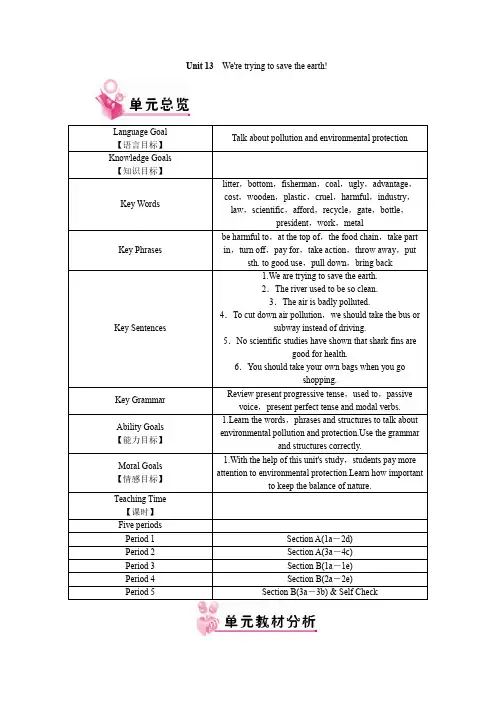
Unit 13We're trying to save the earth!本单元围绕环境保护的话题,并用主题图片表现噪音污染、空气污染、水污染等内容,目的是为了让学生对环境的破坏有一个直观的认识,从而激发学生强烈的社会责任感和对未来发展的思考。
Section A的重点是让学生掌握与环境污染和环境保护相关的词汇和句型,同时引导学生关爱动物、保护环境。
教学难点是让学生学会正确使用连词和结合生活实际讲述如何保护环境。
Section B在Section A所学的基础上,进一步谈论如何保护环境。
教学重点是让学生了解环境保护的方式,并落实到积极的行动当中,同时还有阅读策略和写作技巧的训练。
教学难点是让学生在阅读2a文章之后,根据所给词根找出衍生出的不同词汇,并理解前缀和后缀的不同用法。
The First Period—Section A(1a-2d)Teaching Important Points【教学重点】Key words & phrases:litter,bottom,fisherman,coal,ugly,advantage,cost,wooden,plasticnoise pollution,air pollution,water pollution,be full of,play a part in,turn…into,cut down air pollutionKey sentences:1.Even the bottom of the river was full of rubbish.2.It used to be so clean.3.Everyone in this town should play a part in cleaning it up.4.The air is badly polluted because there are more cars on the road these days.5.The air has become really polluted around here.6.We're trying to save the earth.Key structure:should+do;used to+do;have/has+done;be+done;be+doinge.g.Everyone should help to clean up the river.The air has become really polluted.I used to be able to see stars in the sky.The air is badly polluted.Teaching Difficult Points【教学难点】★Practice the structures to talk about pollution and environmental protection.Teaching Aids【教学工具】A tape recorder,CAI or multimedia courseware.Teaching Steps【教学过程】★Step 1Leading in【新课导入】1.Greeting2.Discussion and reviewDiscuss with the students,like this:T:What kinds of pollution are there these days?S:…T:What causes the pollution?S:…3.Review the words and expressions about the topic.★Step 2Cooperative inquiry【合作探究】1.Finish the task in 1a①Show pictures or play videos about pollution and talk about the pollution.②Read these phrases in 1a.Look at the pictures in 1a and say what they see in the pictures.Write down the words and add more words.③Ask students to say out their words in each kind of pollution.2.Finish the task in 1b①Read the instructions.Get the students to read the contents in the chart and think of what they will fill in the blanks.②Play the recording for the first time.Students listen and fill in the words.③Play the recording a second time.Ask them to check the answers.Then ask the questions.Students answer with full sentences.④Ask more questions to help students learn more details.Then play the recording for the students to role-pay the conversation.3.Finish the task in 1c①Show the key words of the conversation.Ask students to retell the contents in the chart.Like this:What:dirty;bottom,rubbish;fishWhy:littering,putting wasteHow:write to,close down;help to clean up②Read aloud the model dialogue in 1c.Then in pairs,do the oral practice with more words.③Ask two pairs to perform in class.4.Finish the tasks in 2a-2b①Use PPT or pictures to show the four kinds of pollution.Get the groups of students to havea competition to say words about the pollution one by one.land pollution:…air pollution:…noise pollution:…water pollution:…②Get the students to write down these words in their notebooks.③Play the recording for the first time.Students listen and circle the kinds of pollution.Check answers with the class.④Read the sentences in 2b.Predict the contents they will fill in.Play the recording.Students listen and complete the sentences.⑤Play the recording again.Check the answers with the whole class.5.Finish the task in 2c①Read the sample conversation in 2c.Then Read the listening materials and discuss in pairs what causes the two kinds of pollution.②Students work in pairs,making dialogues.③Ask three pairs to role-play their conversations to the class.6.Finish the task in 2d①Talk about the picture in 2d.Ask:What are your ideas for solving the air pollution/waste pollution problem?Present the new words in the conversation.Such as,coal,advantage,wooden,plastic,takeaway,bin,…②Read the conversation in 2d quickly.Find out the problems about environmental pollution in the dialogue.③Read the conversation again.Ask the students to find the ways to solve the problems of air and waste pollution.④Read aloud the conversation by the recording.⑤Learn the useful expressions:What are your ideas for doing…To cut down air pollution,we should…So together,our actions can make a difference and…⑥Role-play or read the conversation in pairs until fluently.★Step 3Homework1.What are your ideas for solving the waste pollution problem?2.Write the words about the four kinds of pollution.3.Translate the following sentences into English.(1)我们正在想办法拯救地球。
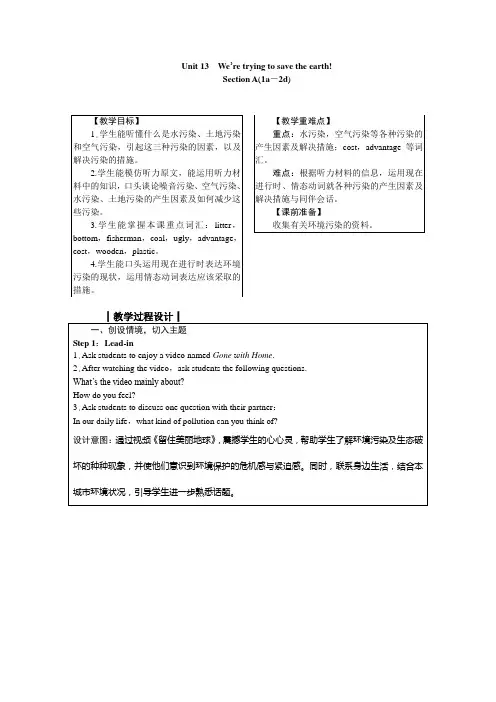
Unit 13We’re trying to save the earth!Section A(1a-2d)┃教学小结┃【板书设计】Unit 13We’re trying to save the earth!Section A(Section A(3a-4c)┃教学小结┃Section B(1a-1e)┃教学小结┃Section B(2a-2e)设计意图:读前预测,为学生在接下来的阅读中获取文章大意作准备。
思维导图可以帮助学生理清文章脉络。
Step 5:Use pictures to teach the new words.When students think about the questions in Step 3,the teacher can write down the new words on the blackboard.And teach them the new words.设计意图:适时呈现词汇,可以减轻学生的阅读压力。
While readingStep 6:Fast reading1.Ask students to look through the article quickly and find out the answer to each question.How many people are mentioned in the passage?Who are they?2.The teacher adds information to the mind-map.设计意图:扫读整篇文章,获取大意,帮助学生把握文章的整体性。
Step 7:Careful reading(Paragraph 2)1.Ask students to read Paragraph 2 carefully and fill in the chart.2.Check answers.3.The teacher adds the information to the mind-map.Step 8:Careful reading(Paragraph 3)1.Ask students to read Paragraph 3 carefully and fill in the chart.2.Check answers.Name What did she make?What materials did she use?Jessica Wong bags old clothes,especially old jeans3.The teacher adds the information to the mind-map.Step 9:Careful reading(Paragraph 4)1.Ask students to read Paragraph 4 carefully and fill in the chart.2.Check answers.Name What did he make?What materials did he use?Wang Tao beautiful art pieces iron and other materials from old cars3.The teacher adds the information to the mind-map.Which things can be done by common people every day?Which things have to be done by governments and organizations?Common people Governments Organizations2.Ask several groups to give a report.设计意图:教师让学生对所学的保护环境的措施进行归纳和分类,培养学生分析问题和解决问题的能力。

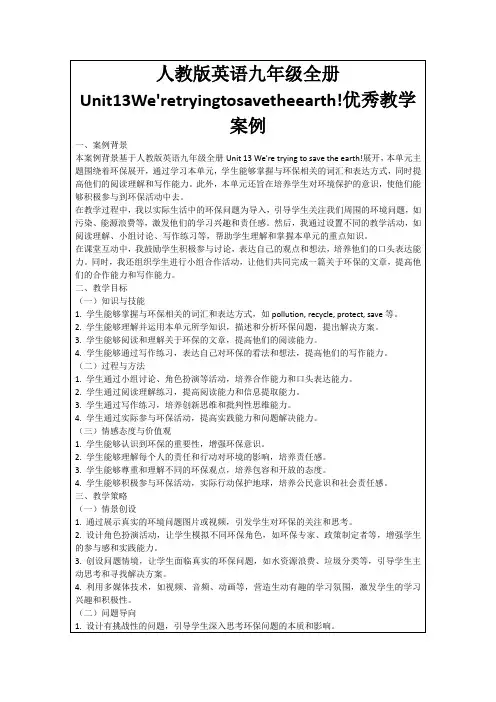
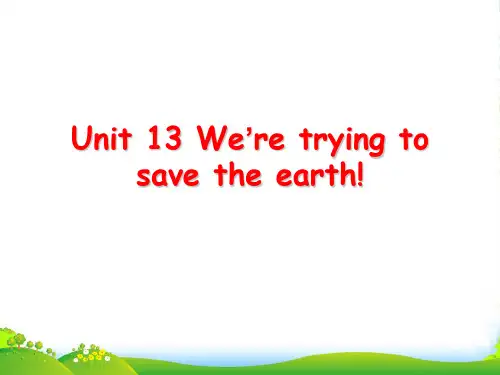

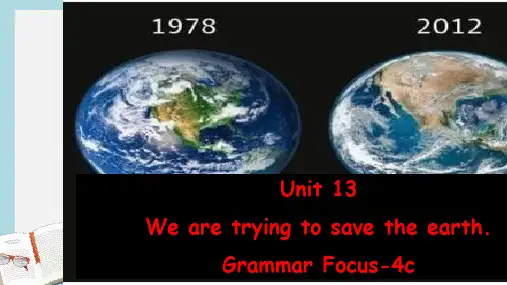
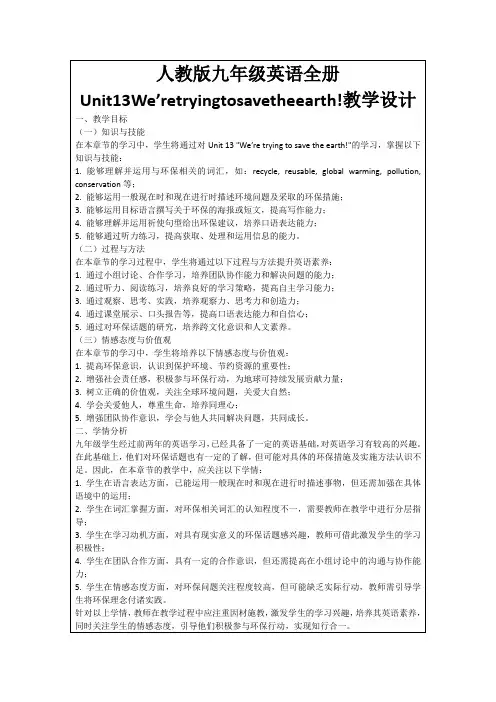
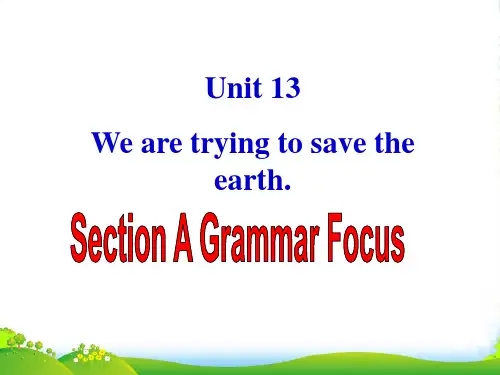
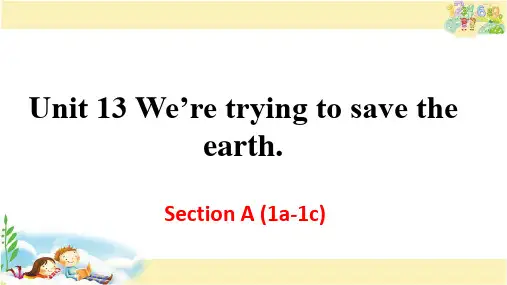
Unit 13 We’re trying to save the earth!知识点和练习Phrases 1.noise/ air/ water pollution 噪音/ 空气/ 水污染the bottom of .......的底部be full of rubbish 装满垃圾 2.throw litter into the river 把垃圾扔进河里 3. put waste into the river 把废品放进河里4.write to sb. 给某人写信5. close down (工厂)关闭/ 使停业turn off 关闭(电源)6. clean up 打扫干净7. Play a part in在......方面起作用8. on the road 在路上9. burn coal烧煤10. pollute the air污染空气11. a lot of black smoke 许多黑烟12. throw away 扔掉;抛弃throw away things扔掉/抛弃东西13. in public places 在公共场所14. turn into变成turn A into B 把A变成B 15. solve the problems 解决问题16. cut down 减少,砍伐(树木)cut up 切碎cut off 切除,切掉,切断17. ride a bike 骑自行车18.the advantage(s) of ......的优点19. be good for (反义:be bad for )对......有益20. waste pollution 废品污染too much waste太多的废物21. bring a bag to go shopping 带购物袋22. wooden chopsticks 木筷子23.plastic forks 塑料叉子24. buy takeaway food 买外卖食物25. make a difference to sb./ sth. 对某人/ 某物有影响/ 起作用26. lead to a better future 引向一个更好的未来lead to 通向;导致27.take part in+ 具体的活动=join in + 具体的活动参加28.hear of/about 听说hear from sb.收到某人的来信29. in southern China 在中国南部30. a bowl of shark fin soup一碗鱼翅汤31. kill a whole shark 杀一整只鲨鱼32. each time每次33. not only ... but also ... 不仅......而且...... (并列作主语时,谓语动词采用就近原则;not only 位于句首时,它后面的主谓采用部分倒装,但but also后面的主谓不倒装)34.be cruel 残忍的35. be harmful to = be bad for 对......有害be harmful to the environment 对环境有害36.throw back into 扔回at the top of 在......顶部37. the food chain 食物链38. in the ocean’s ecosystem 在海洋生态系统中39. drop too low 下降太多40. bring danger to sb. 给某人带来危险41. be endangered 濒临灭绝的42. in fact 实际上43. in this industry 在这个行业里44. be traded 被贸易44. the number of+pl ......的数量(作主语时,谓语动词用单数形式)a number of+pl 许多(作主语时,谓语动词用复数形式)45.fall by 下降46.in the last / past +时间段在过去的...... (是现在完成时的标志)47.environmental protection groups 环保组织48. teach the public 教育公众49. develop the law形成法律50. stop the sale of shark fins 阻止鲨鱼鱼鳍的销售51. so far 到目前为止52. be in danger处于危险中53. scientific studies 科学研究54.consider doing sth. 考虑做某事55. help out帮助解决困难56.improve the environment 改善环境57. ( can/ can’t /couldn’t ) afford to do sth . 能/不能承担做某事58. take action 采取行动59.save electricity节约电60. pay for 付费61. add up 累计/累加62. improve the environment 改善环境63. use public transportation 使用公共交通运输64. parents with children 带孩子的父母65.stop riding in cars 停止开车66. recycle books and paper 回收书和纸67. turn off the shower 关掉淋浴器68. wash one’s hair 洗头发69. use paper napkins 用餐巾纸70. put sth. to good use 好好利用某物71. have a creative mind 有一个充满创意的头脑72. a most / very unusual woman一个非常不寻常的妇女the most unusual woman最不寻常的妇女73. build/ make sth. out of sth. 用某物修建/制造某物make a kite out of paper 用纸制作一只风筝74. pull down 拆下;摧毁75.upside down 上下颠倒,倒转turn upside down 翻转turned upside down 被翻转过来的76.win a prize获奖77. the Help Save Our Planet Society帮助拯救我们的星球协会78. be an inspiration to sb. 对某人是一种激励79.be good at = do well in擅长于80. use sth. to do sth. 用某物做某事81.open a small shop开一个小商店82. set up a website建立一个网站82. plan to do计划做某事83. set up a small business 经营一个小生意83.be known for+原因= be famous for+原因因......而出名be known as+职业= be famous as+职业作为......而出名84. make beautiful art pieces制作漂亮的艺术作品85. set up a theme park建立一个主题公园86.the importance of.... .......的重要性86. bring happiness to sb.把快乐带给某人87. bring back to life 使恢复生机/ 生命/ 使.......苏醒综合测试题一单项选择题()1.I don't think you've been to Disneyland, ________?A.aren't you B.haven't you C.do you D.have you()2.The villager built the bridge ________stones last year.A.out of B.out C.to D.for()3.My brother watched the football match instead of ________ his homework.A.doing B.do C.did D.does()4.—Do you know the movie Harry Potter? —Yes.I________ it twice.It's funny.A.saw B.see C.have seen D.will see()5.More natural protection areas should ________ in the future.A.set up B.to set up C.be set up D.setting up()6.—Do you like playing computer games? —No, but I ________.A.used to B.didn't C.do D.don't()7.I have never________ the strange animal before.A.heard from B.Listened C.listened to D.heard of()8.—Miss Liu, when did you come here?—In 2012.I________ here for two years.A.have been to B.have gone to C.have come D.have been()9.Lots of food and water___to Ya'an, Sichuan Province immediately after the earthquake happened.A.were sent B.are sent C.send D.sent()10.The children were hungry and the salad was quickly________ up.A.eating B.ate C.eaten D.eat()11.Look, so many passengers________ with their smart phones on the underground.A.played B.will play C.are playing D.have played()12.Great changes________ in Daqing since the 1990s.A.took place B.were taken place C.have taken place D.have been taken place ()13.—How much does the car________?—Oh, that's not too dear.It's only 100,000 yuan.A.spend B.cost C.take D.pay()14.—Have you________ the school sports meeting? —Yes, I have.A.take part B.taken part C.taken part in D.took part in()15.—What________ I do? —You'll________ study from now on if you want to go to college.A.can; may B.should; can C.should; have to D.may; could()16.________ he ________ on well with his friends this term?A.Did; get B.Does; get C.is; gotten D.Is; getting()17.Our teacher told us waste bottles should be________ good use.A.put B.put to C.to put D.puts()18.—John, your room is really in a mess.It needs________. —Sorry, Mum.I'll do it at once.A.cleans B.cleaned C.to clean D.to be cleaned()19.It’s time ______ him_____ up. Or he will be late for school.A. Of, to getB. for, to getC. Of, gettingD. for , getting()20.The are so many good restaurants. I can’t decide _____ ?A. what to eatB. how to eatC. where to eatD. when to eat二、完形填空Nancy's grandma lived in a big old house in New York.Nancy and her parents went to see her each summer.Nancy __21__ to see Grandma and bake (烘烤) with her.She liked to play cards with her, too.This summer, however, Grandma did not seem __22__.She seemed to be worried about something.“Wh at's wrong with Grandma?” Nancy asked her mom.“The __23__ pollution is bothering (使烦恼) her,” Mom said.“Do you _24__ the noise from all those cars?” Nancy asked.“Yes,” Mom said.“When Grandma moved here many years ago, there wasn't such a big _25_ here.Now there is a big road that is used to go to work easily in the city.Big trucks deliver (运载) food all over, too, by __26__ this road.They make so much noise.The noise pollution really bothers Grandma.”“I know _27__ water pollution and air pollution are.I learned about them in school, but what is noise pollution?” Nancy asked.“Pollution is __28__ that is bad for you,” Mom said.“Noise pollution can influence someone's __29__.Grandma's blood pressure goes up because of too much noise.She also has trouble __30__ with all the traffic at night.Grandma's hearing has been hurt by the noise, too.”()21.A.loved B.hated C.wanted D.feared()22.A.interesting B.Happy C.healthy D.well()23.A.water B.soil C.air D.noise()24.A.mean B.get C.tell D.point()25.A.factory B.pool C.road D.railway()26.A.cleaning B.using C.building D.making()27.A.what B.how C.where D.when()28.A.everything B.anything C.something D.nothing()29.A.diet B.habits C.health D.feelings()30.A.listening B.sleeping C.walking D.thinking三、阅读理解A large part of China experienced larger amounts of smog (雾霾) than usual and the air was badly polluted.The distance one could see was shorter than 1,000 meters in Beijing, Tianjin, and the provinces of Hebei, Henan, Shandong and Anhui.In some areas, it was down to 200 meters.People usually set off firecrackers (爆竹) to celebrate the Spring Festival.But because of the smog, this year seemed very quiet.It was really different.A man called Zhang Wei said that his friends and he hadn't set off a single firecracker.“We all suffered from last month's smog.If we don't call an end to the firecrackers, the environment will get worse and worse during t he holiday.” Said Zhang Wei.He called on more people to set off fewer firecrackers during this year's Spring Festival holiday by putting up a notice in his neighborhood.More Chinese looked forward to celebrating the holiday in a greener way.They decided not to set off firecrackers.They also decided not to waste food.They said that the new celebrations sounded fashionable.To clean the sky, more than ten provinces including Guangdong, Zhejiang and Jiangsu have started to use national 4 standard (标准), which is expected to reduce (减少) vehicle emission (车辆排放) by 30% to 50%.Beijing even has started to use the stricter national 5 standard.We still have a lot to do to improve the air quality.For example, using public transportation as much as possible is not a hard thing for us to do, but it matters a lot.()31.What happened in a large part of China this January?A.It experienced larger amounts of smog. B.People set off lots of firecrackers.C.There was a heavy rain. D.Many car accidents happened.()32.How do people usually celebrate the Spring Festival in China?A.By putting up a notice B.By setting off firecrackers.C.By not wasting food. D.By using public transportation.()33.How many provinces have started to use national 4 standard?A.Three. B.Six. C.Eight. D.More than ten.()34.Which of the following is NOT true according to the passage?A.Zhang Wei didn't set off a single firecracker this Spring Festival.B.We should use more public transportation to help reduce the air pollution.C.Zhejiang has started to use national 4 standard to reduce vehicle emission.D.More Chinese think the celebration of setting off firecracker is fashionable.()35.What's the best title for the passage?A.How to Reduce the Vehicle Emission B.How to Improve the Air QualityC.What Do Chinese Do in the Spring Festival D.Using Public Transportation四、首字母填空Travel can teach kids more than a textbook. Travelling with kids is good f 1 them. They can find new interests. Travel makes information alive for kids, and makes it much more exciting than studying textbooks or d 2 experiments in the lab. While traveling, they learn h 3 to deal with new situations, and communicate with other people. They learn patience, because sometimes i 4 takes a long time to get to some exciting or interesting places.I’ve been traveling since I was seven years old. For me, to stop traveling would be like taking something a 5 from my soul(灵魂). I can’t live without traveling and I wouldn’t be who I am if I don’t travel. Some people think it’s h 6 to travel after having kids. But in my opinion, when people become parents, it doesn’t m7 they couldn’t travel any more. My children have been traveling since they were three weeks old.Bringing a new life into the world comes with many responsibilities(责任)and I’d love to be a good mother. One of my duties is to e 8 my children. I’m so thankful that my parents took me on family trips when I was y 9 .I’ve learned that the outside world is more colorfu l than the little one I was living in. Of course, I want to pass these travel e 10 on to my children.I value the memories I have traveling with my children. I’m sure they will always remember them in their lives.1. 2. 3. 4. 5.6. 7. 8. 9. 10.1When his friend Bob saw him, he laughed and said, "What has 2 to your hair, Jack?"Jack said, "I tried a new barber's shop today, because I wasn't quite satisfied(满意的) with my 3 one, but this one seems even 4 ."Bob agreed. "Yes, I think you're right, Jack. Now I'll tell you 5 to do when you go into a barber's shop next time: look at all the barber's hair, find out 6 hair looks worst, and then go straight to him.""Why shall I go to him?" Jack asked. "But that would be foolish!""Oh, no, it wouldn't," answered Bob. "Who 7 that man's hair? Just think it. He couldn't cut it 8 , could he? Another of the barbers cut it. So you know he can't be the worst barber."1. 2. 3. 4. 5. 6. 7. 8.六.书面表达我们知道,由于环境污染、人类的残杀,很多野生动物濒临灭绝。
人教版英语九年级Unit 13《We’re trying to save the earth》全单元说课稿一. 教材分析人教版英语九年级Unit 13《We’re trying to save the earth》全单元主要围绕环保主题展开,通过学习本单元,学生能够掌握与环保相关的词汇和表达方式,了解人们为保护地球所采取的行动,提高环保意识。
本单元包括两个阅读文本,分别是关于地球一小时活动和一位美国学生的环保故事。
通过阅读和实践活动,学生能够提高阅读理解能力,培养运用英语进行交流的能力。
二. 学情分析九年级的学生已经具备了一定的英语基础,能够理解和运用一些基本的英语表达。
但他们在阅读理解,尤其是对于长篇阅读材料的理解上还存在一定的困难。
此外,学生对于环保主题的认识和关注程度不同,因此在教学过程中需要引导学生深入思考,提高他们的环保意识。
三. 说教学目标1.知识目标:学生能够掌握本单元的重点词汇和表达方式,理解阅读文本的内容。
2.能力目标:学生能够运用英语进行阅读理解,提高阅读能力;能够运用所学知识进行交流和讨论。
3.情感目标:学生能够增强环保意识,认识到保护地球的重要性。
四. 说教学重难点1.重点:本单元的重点是让学生掌握与环保相关的词汇和表达方式,提高阅读理解能力。
2.难点:学生对于阅读文本的理解和运用所学知识进行交流和讨论。
五. 说教学方法与手段1.教学方法:采用任务型教学法,引导学生通过阅读、讨论、实践活动等方式,提高英语运用能力。
2.教学手段:利用多媒体教学设备,展示相关图片和视频,帮助学生更好地理解文本内容。
六. 说教学过程1.导入:通过展示地球环境的图片,引导学生思考环保问题,激发学生的学习兴趣。
2.阅读理解:学生自主阅读文本,回答相关问题,教师进行讲解和指导。
3.小组讨论:学生分组讨论,分享各自的观点和感受,教师进行巡回指导。
4.实践活动:学生根据所学内容,进行角色扮演或写作练习,教师进行评价和指导。
Unit 13 We’re trying to save the earth!知识导航语言目标谈论污染和环境保护。
Section A重点单词1. litter v.乱扔n.垃圾2. bottom n.底部3. coal n.煤4. ugly adj.丑陋的5. cost v.花费n.花费6. wooden adj.木制的(wood n.木材)7. plastic adj.塑料的n.塑料8. method n.方法9. cruel adj.残酷的10. harmful adj.有害的(harm n.害处)11. industry n.工业12. law n.法律13. afford v.承担得起重点短语1.make a difference 起作用;有影响2. take part in 参加3. turn off 关掉4. pay for 付费;付出代价5. cut down 减少6. lead to 导致7. hear of 听说8. cut off 切除重点句型1.We’re trying to save the earth. 我们在努力拯救地球。
2. The rive used to be so clean. 这河流过去是如此的清澈。
3. The air is badly polluted. 空气被严重污染。
4. The method is not only cruel, but also harmful to the environment. 这种方法不仅残酷,而且对环境也有害。
Section B重点单词1. recycle v.回收利用2. gate n.大门3. bottle n.瓶子4. president n. 负责人5. work n.作品6. metal n.金属重点短语1. throw away 扔掉2. put sth. to good use 好好利用3. put … down 拆下4. upside down 上下颠倒5. bring back 恢复重点句型1. And the gate in front of her house is made of rocks and old glass bottles. 她房子的前门是由岩石和旧玻璃瓶子制成的。
2. Not only can the art bring happiness to others, but it also shows that even cold, hard iron can be brought back to life with a little creativity. 不仅艺术品能给人们带来快乐,而且冰冷坚硬的钢铁在艺术创作下也恢复了生命。
核心语法1. 复习现在进行时、used to句型、被动语态、现在完成时和情态动词。
Section A (1a-2d)【基础预习】I. 写出下面单词的意思。
1. littler ______2. bottom ________3. fisherman _____ 3. coal __________5. ugly ________6. advantage ______7. cost ________ 8. wooden ________9. plastic _______II. 把下面的短语与汉语意思搭配。
1. make a difference A. 参与2. cut down B. 充满3. lead to C. 减少4. be full of D. 起作用5. play a part in E. 导致【重点讲练】1. The air has become really polluted around here. 这儿的空气已经被污染了。
辨析:turn, get 与become⑴become多指身份、职位等的变化,它强调变化的过程已经完成,后面可接名词或形容词。
He becomes a teacher. 他成了一名老师。
⑵get多用于口语,表示一种变化过程,强调的是“渐渐变得”,后常接形容词的比较级形式。
In winter the days get shorter. 冬季白天变得较短。
⑶turn指在颜色和性质等方面与以前的完全不同,强调变化的结果。
Leaves turned brown in the mountains. 山里的树叶已变成了棕色。
【小试牛刀】用turn, get 和become填空。
①Her mother ____ angry when she heard the news.②It’s _____ darker and darker outside.③The milk has _____ bad.2. To cut down air pollution, we should take the bus or subway instead of driving. 为了减少空气污染,我们应该乘坐公共汽车或者地铁,而不是开车。
cut down 意为“减少”;是“动词+副词”结构的短语,所带的宾语为名词时,宾语可位于down的前面或后面;为代词时,只能位于down前面。
You’d better cut the article down to about 2,000 words. 你最好能把这篇文章压到两千字左右。
【拓展】cut down 还可表示“砍倒”的意思。
They cut down the big tree. 他们砍倒了这棵大树。
cut off 切断;切除cut into 把……切成……cut up 切碎cut in 插队【小试牛刀】单项选择—Did you tell it to Jack?—Yes, but we were ____ in the middle of our telephone conversation.A. cut downB. cut offC. cut upD. cut into3. It’s good for health and it doesn’t cost anything! 它对身体有好处并且不会花费任何东西。
【小试牛刀】单项选择1. —Do you take exercise every day?—Yes. I always ___thirty minutes after supper.A. spendB. costC. takeD. pay2. I _________ $300 for the bike.A. tookB. spentC. costD. paid【达标训练】Ⅰ. 用方框中所给词的适当形式填空。
cost, wood, coal, bottom, litter1. Don’t throw _____ (垃圾) everywhere.2. In winter, many people burn ____ (煤) to keep warm.3. The police found a body at the ____ (底部) of the lake.4. The _____ (费用) of living in big cities is very high.5. He keeps a rabbit in a big ____ (木制的) box.II. 单项选择。
1. He ____ go out with his parents, but now he ____ staying at home alone.A. used to; is used toB. is used to; used toC. use to; is used toD. is used to; is used to2. The interesting book _____ me 10 yuan.A. spentB. tookC. paidD. cost3. We must do something useful to ____ pollution.A. cut offB. cut upC. cut downD. cut in4. Smoking can _____ lung cancer. You’d better give it up.A. work onB. lead toC. take awayD. put out5. —What are the _____ of bike riding?—It can help cut down air pollution.A. advantagesB. reasonsC. resultsD. ideasIII. 根据汉语提示完成下面的句子。
1. 多一个人少一个人无所谓。
One person wouldn’t ____ ____ ____.2. 这个木箱时装满了书。
The ____ box ____ ____ ____ books.3. 不健康的饮食对这种疾病的传播起一定的作用。
Unhealthy foods ___ ___ ___ ___ the spread of the disease.4. 这条小路通向公园。
The path ____ ____ the park.5. 我错拿了你的包。
I took your bag ____ ____ mine by mistake.Section A (3a-4c)【基础预习】I. 根据汉语提示写出下面句中所缺的单词。
1. I have a simple and easy ____ (方法) to solve the problem.2. We shouldn’t be ____ (残忍的) to animals.3. It’s ____ (有害的) to your health to drink to much.4. The city is the _____ (工业) center of the country.5. The car is too expensive, I can’t ___ (买得起) it.II. 写出下面短语的意思。
1. take part in __________2. turn off ____________3. pay for ____________4. hear of _____________5. be harmful to ___________【重点讲练】1. The method is not only cruel, but also harmful to the environment. 这种方法不仅残酷,而且对环境也有害。
harmful 形容词,意为“有害的”。